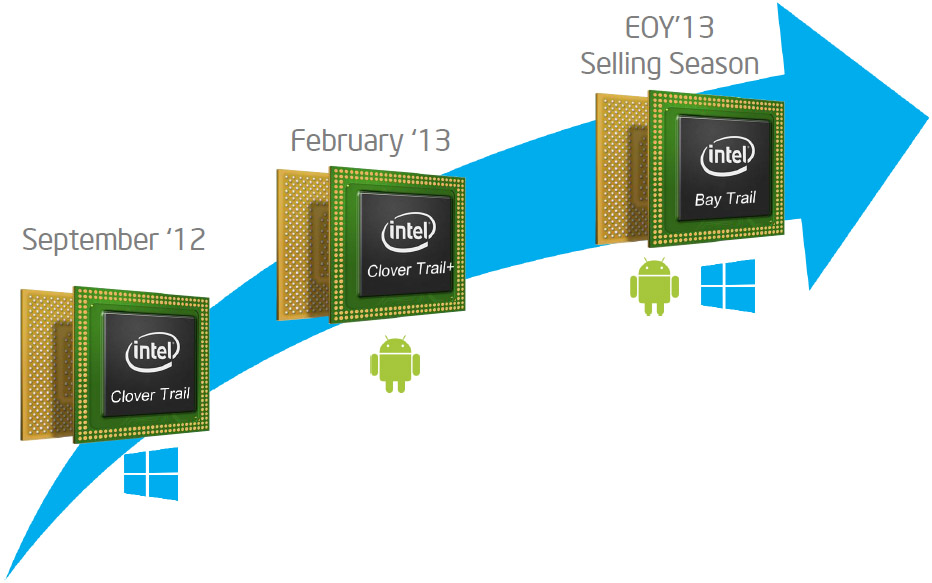Bay Trail On The Desktop: Celeron J1750 Gets Benchmarked
Last week, Intel rolled out its Bay Trail SoCs based on the Silvermont architecture. The company focused most intently on its tablet-oriented Atom models. However, we got our hands on a Celeron J1750, soldered onto a motherboard, for desktop testing.
If The Gloves Weren't Off Before, They Are Now...
Intel employs more than 100,000 people. A great many companies are larger. But still, you don’t change the direction of an organization doing more than $50 billion in revenue a year quickly, or without a specific endgame. And yet, Intel is intent on recalibrating its focus. In fact, a pre-IDF note I received was even more explicit than that.
Resetting the course of the company with a clear emphasis on mobile computing leadership. Wow. Take that Apple, Qualcomm, Nvidia, and Samsung. But while Intel’s home court rallying cry comes as a bit of a surprise, its playbook through the end of next year certainly isn’t.
Back in June, we spent time at Intel’s headquarters in Santa Clara to get briefed on the architecture that’d power its next generation of low-power desktop, notebook, tablet, appliance, smartphone, and server CPUs. The resulting story, Intel Silvermont Architecture: Does This Atom Change It All?, gave us a look at a design that promised either significantly more performance per watt or great power savings at a given performance level. We were naturally eager to get our hands on an example of Silvermont in action. More on that shortly.
Bay Trail, Powered By Silvermont, In Your Next Tablet?
Last week, Intel introduced the family of SoCs previously referred to as Bay Trail, which address the tablet, notebook, and desktop markets. Although you’re going to see Bay Trail-based processors branded as Atom, Celeron, and Pentium, they all employ the Silvermont core design, albeit within a range of power and performance levels.
In keeping with its mobile focus for IDF, though, Intel emphasized the tablet-specific quad-core Atom Z3700 and dual-core Atom Z3600 line-ups. They succeed the dual-core, quad-threaded Atom Z2760, which saw some play in a number of tablets running Windows 8. None of those tablets really caught on, though. Why not? Well...
...to begin, they were expensive. Samsung’s ATIV Smart PC 500T with 64 GB of storage sold for $750 with its optional keyboard. They weren’t very fast, either. Finally, we stumbled on some pretty severe quality issues with the Samsung and Acer units—two of the highest-profile Atom-based tablets. Though they were able to compete against Nvidia’s Tegra 3 and Qualcomm’s S4 Pro in measures of efficiency, after a while we found ourselves picking those Atom-based platforms up and setting them right back down.
And that’s actually part of what makes Bay Trail so exciting. Intel is expanding its horizons, maintaining its Windows focus, but branching out to enable x86 on Android (a process that began earlier this year with Clover Trail+). That should help widen Atom’s price band. As we know, Intel also makes some pretty broad claims about Bay Trail’s performance, which we'll put to the test shortly. We’re pretty certain that its improvements will translate to better responsiveness. Quality issues need to be ironed out by the manufacturers. But Intel has its engineers busy working with partners to improve their designs, and we can only hope many lessons were learned from Clover Trail.
Get Tom's Hardware's best news and in-depth reviews, straight to your inbox.
Intel makes clear where you’ll find Bay Trail-based SoCs and Ivy Bridge/Haswell-based processors by charting price over a range between maximum mobility and peak performance. All the way to the left, tablets with Atom inside should stretch from $200 to about $550, while Core-based devices top out in the $850 range. Divisions are also made in the notebook space. Atom will not go into Ultrabooks-branded platforms, but is expected to show up in detachable and convertible systems, otherwise referred to as two-in-ones.
Current page: If The Gloves Weren't Off Before, They Are Now...
Next Page The Atom Z3000 SoC Architecture-
SteelCity1981 only 2mb of l2 cache for 4 cores. talk about starving 4 cores with 2mb of l2 cache.Reply -
DjEaZy ... interesting is the modular core thingy.. it ir like the FX module from AMD... 2 cores on joined L2 cache? Hmm... and GPU on the silicon... it seams, intel waits till the software is there...Reply -
stickmansam Reply11551610 said:... interesting is the modular core thingy.. it ir like the FX module from AMD... 2 cores on joined L2 cache? Hmm... and GPU on the silicon... it seams, intel waits till the software is there...
Shared L2 cache exists on Intel's side during the Core 2 era with two or more cores sharing the L2 cache, similar to how L3 cache is shared now except there is an additional private L2 cache. Basically, with Nehalem, Intel moved the shared cache a level lower to L3 and put in a new private cache (L2). GPU on the same die/chip has been on Intel's side too for quite a while as well....
11551497 said:only 2mb of l2 cache for 4 cores. talk about starving 4 cores with 2mb of l2 cache.
The i5s have actually less cache than the Q9x50's so cache size isn't everything. Their ipc is still lower than the Athlon IIx4's which have similar amounts of cache are not that bottle necked (compared to Phenom II's, maybe 20% slower?). Cache implementation also matters and the shared L2 should be better than the piecemeal Athlon II L2, provided the cores don't thrash each other.
Bay Trail is a quite interesting chip with good enough performance to pretty much beat out most ARM chips in tablets yet provide comparable power efficiency and graphics. The price is not too high either, with the top end chip ~$40, making it at least somewhat competitive with ARM. The ability to run Android/Linux/Windows 8 means that OEM's can build one product to sell to different markets and save on production line costs. It also lets them adjust the OS to meet market demand on the go potential (ship non selling OS version back to factory and load OS that sells better and send it back out). ASUS seems to have something like that going on with the T100 having buttons half way between Windows and Android and no Windows branding.
This all makes me want to grab a Bay Trail and run both Android and Windows on it, have Windows when I use it connected to a screen for desktop and run desktop apps and then Android on the go so I get the larger app store (Windows if I am lazy). -
vipervoid1 There is Kabini in the review ??Reply
Why compare Richland with this ??
Isn't Kabini is the one to compare ?? -
runswindows95 Then again, the thing to keep in mind these CPU's aren't gaming / workstation CPU's. These CPU's will quite honestly work for the majority of PC owners, who mainly do social media and Youtube. A quad-core that only uses 10W intrigues me a lot since I don't game, but do a lot of heavy word processing.Reply -
ojas Reply
Agreed.11551718 said:There is Kabini in the review ??
Why compare Richland with this ??
Isn't Kabini is the one to compare ??
Though, Tech Report and AnandTech have previewed the Z3770 and put it up against mobile chips and Kabini.
(hint: the 4w Z3770 matches a 15w A4-5000 Kabini and soundly thrashes ARM in CPU performance)
http://techreport.com/review/25329/intel-atom-z3000-bay-trail-soc-revealed
http://www.anandtech.com/show/7314/intel-baytrail-preview-intel-atom-z3770-tested -
de5_Roy i sorely missed a kabini setup in the benches and efficiency tests. i woulda liked to see both bay trail and kabini socs run 1080p and 1600p gaming (tablet oriented).Reply
a few nitpicks:
in the test hardware chart - a4 4000 doesn't have L3 cache. afaik, neither does baytrail (1MB shared L2).
in the bga 65w skus vs bga 10 skus table, the core i- cpus clockrates are base clockrate, turbo is missing while baytrail socs' burst clockrate is reported while base clockrate is absent. -
Wisecracker Reply11552261 said:
Agreed.11551718 said:There is Kabini in the review ??
Why compare Richland with this ??
Isn't Kabini is the one to compare ??
Though, Tech Report and AnandTech have previewed the Z3770 and put it up against mobile chips and Kabini.
(hint: the 4w Z3770 matches a 15w A4-5000 Kabini and soundly thrashes ARM in CPU performance)
http://techreport.com/review/25329/intel-atom-z3000-bay-trail-soc-revealed
http://www.anandtech.com/show/7314/intel-baytrail-preview-intel-atom-z3770-tested
Not according to Tom's ...
Power consumption looks great ... especially compared to a 65w Richland desktop (WTF, THG?) ... but the A4-5000 remains quite formidable in efficiency according to Tom's own testing
Graphics performance compared to the AMD SoCs must blow, or it would have been hyped to the max. I suspect this means Bay Trail will be Temash'd (or, Kabini'd).
-
CaedenV Looks like these new Atom based Celerons and Pentiums are what I want to look for in my little always-on server build I am prepping for. Extremely low power, enough performance to run a gigabit NAS, and hopefully some passive or other extremely quiet cooling solutions. I just hope that the motherboards offer some RAID options to work with in FreeNAS and the price is appropriately cheap.Reply



